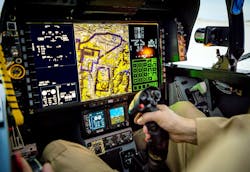Navy orders targeting network embedded computing avionics system for attack jets from Boeing and L3Harris
PATUXENT RIVER NAS, Md. – U.S. Navy aerial warfare experts are beefing-up the capability of carrier-based jet fighter-bombers to share networked targeting information with other aircraft and weapons systems.
Officials of the Naval Air Systems Command at Patuxent River Naval Air Station, Md., announced a $39.7 million order to the Boeing Co. Defense, Space & Security segment in St. Louis last week for the Distributed Targeting Processor-Networked (DTP-N) for U.S. and Australia to carry out anti-ship warfare from the F/A-18E/F and EA-18G attack jets.
Boeing will provide 63 DTP-N B kits -- 32 for the Navy and 31 for -- Australia; and 56 DTP-N A1 kits -- 32 for the Navy and 24 for Australia -- as well as DTP-N cyber security support.
The DTP-N network and computer avionics, from L3Harris Technologies Inc. in Melbourne, Fla., is a high-performance data- and signal-processing computer that bridges gaps between onboard and external data networks in real time.
The system incorporates the tactical targeting network technology and produces a common operating picture. It has one air-cooled weapon replaceable assembly consisting of a chassis, backplane assembly, and several removable embedded computing modules. Boeing is the systems integrator of the F/A-18E/F and EA-18G attack aircraft.
DTP-N is designed to reduce pilot workload by providing actionable information to the warfighter on the large-area display. It computers algorithms quickly, and provides performance scalability, technology insertion and functional growth capability via an open system architecture.
The DTP-N multilevel security capability supports several security enclaves on board and provides secure interoperability with other subsystems.
Related: Applying zero trust principles to embedded systems
The DTP-N is designed to improve mission processing, subsystem interfacing, display generation, and secure multilevel information management. It hosts user-generated software with third-party and supplier-provided software.
The DTP-N computer provides a gateway from existing F/A-18E/F and EA-18G avionics to new external wireless tactical networks. It connects to the L3Harris Tactical Targeting Network Technology (TTNT) through Multifunction Information Systems Joint Tactical Radio System (MIDS JTRS) Ethernet interfaces to increase bandwidth, and to collect and share time-critical information using voice, streaming video, and still imagery.
On this contract Boeing will do the work in St. Louis, and should be finished by September 2024. For more information contact Boeing Defense, Space & Security online at www.boeing.com/company/about-bds, or Naval Air Systems Command at www.navair.navy.mil.

John Keller | Editor-in-Chief
John Keller is the Editor-in-Chief, Military & Aerospace Electronics Magazine--provides extensive coverage and analysis of enabling electronics and optoelectronic technologies in military, space and commercial aviation applications. John has been a member of the Military & Aerospace Electronics staff since 1989 and chief editor since 1995.

